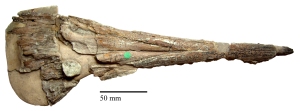As I’m sure some of you may have noticed, I haven’t posted any new things recently — this month in fact. It has been quite a busy time: I’ve taken visits to both London and Dorchester, acquired an ichthyosaur that I am planning to prepare, and spent an inordinate amount of time thinking about cristi supraorbitali and other obscure but important ichthyosaur features.
I also think that I have discovered my most favourite ichthyosaur yet: Besanosaurus leptorhynchus from the Middle Triassic (Upper Anisian–Lower Ladinian) of Besano, northern Italy. I thank Christiano Dal Sasso for kindly sending me a copy of his and Giovanni Pinna’s paper (Dal Sasso and Pinna 1996). It features the most wonderful map of the complete specimen (below; from Dal Sasso and Pinna 1996 fig. 8).

Besanosaurus leptorhynchus from the Besano Formation (Grenzbitumenzone) near Besano, northern Italy. From Dal Sasso and Pinna (1996).
In London, I went to the Natural History Museum (NHM), which is a treasure trove of fossils — a palaeontologist’s paradise. There I looked through some of the Kimmeridgian ichthyosaur material (there’s too much to do in a day!); particularly looking for bits of Nannopterygius. Aside from the main skeleton on the wall of the Marine Reptile Gallery, there is very little material for this genus. The isolated hindpaddle was my main concern (below; layout suggested by SV-POW), but there’s also several vertebrae.

Isolated hindpaddle of Nannopterygius enthekiodon, from the Kimmeridgian, in most views as suggested on SV-POW. There has been some slight dorsoventral crushing, hence the significant difference in size of the proximal femoral processes. Abbreviations: car: carpal, dp: dorsal process, fem: femur, fib: fibula, int: intermedium, tbl tibiale, tib: tibia, vp: ventral process.

Unidentified ‘ichthyosaur’ vertebrae in the collections of the Natural History Museum, London. Still in their plaster wrapping, centra with articulated neural spines.
Whilst in the NHM, I also took a look through the drawers and found a nice set of vertebrae, which were unmarked and only partially removed from their cast, and a very crushed skull of Aegirosaurus ‘Ichthyosaurus’ leptospondylus from the Solnhofen Limestone of Germany (Bardet and Fernández 2000): the same place the famous ‘missing link’ Archaeopteryx comes from.

Ichthyosaurs leptopterygius from the Solnhofen Limestone of southern Germany. Significantly crushed, in dorsal view.
References
BARDET, N. and FERNÁNDEZ, M. S. 2000. A new ichthyosaur from the Upper Jurassic lithographic limestones of Bavaria. Journal of Paleontology, 74, 503–511.
DAL SASSO, C. and PINNA, G. 1996. Besanosaurus leptorhynchus n. gen. n. sp., a new shastasaurid ichthyosaur from the Middle Triassic of Besano (Lombardy, N. Italy). Paleontologia Lombarda, New Series, 4, 1–22.
MCGOWAN, C. and MOTANI, R. 2003. Ichthyopterygia. In SUES, H.-D. (ed.) Handbook of Paleoherpetology. Vol. 8. Verlag Dr. Friedrich Pfeil, Munich, 175 pp.

Fantastic to see this form of all-orthogonal-views illustration!
Thanks, unfortunately I didn’t manage to get a decent distal image. I’ll be looking at the Oxford Clay material, so there is likely to be many more to come!
Hello Ben, I was wondering if you could take a look at a partial Icthythosaur that I found a Lavernock and let me know your thoughts regarding species. Thanks Jonathan
http://www.discussfossils.com/forum/forum_posts.asp?TID=128&PN=14&title=lavernock-wales and then the Post: 17 Mar 2012 at 6:07pm
Jonathan,
That’s a great specimen you have there, and you’ve prepared it very nicely.
Unfortunately, as there is not much material, it is quite a difficult specimen to identify, but the paddle is one of the main diagnostic features, and is present, so it’s not impossible. In my opinion, it is probably an Ichthyosaurus, because of the shape of the paddle bones. I cannot see any notches on the bones, also suggesting Ichthyosaurus (although some do have notches). I don’t think I can go any further than Ichthyosaurus, because of the material, and that I’m not a complete expert (yet!). There’s a decent paper at http://www-alt.naturkundemuseum-bw.de/stuttgart/pdf/b_pdf/B298.pdf which gives much more detail on ichthyosaurs, with drawings of many species at the end.
The size of the sclerotic ring compared to the paddle (which is not complete, but nearly so) makes it likely that this is a juvenile ichthyosaur. These are not uncommon, many have been found in similarly aged rocks from southern Germany, but again makes identification difficult as the bone shape and configuration changes quite a bit during growth.
Hope this helps you a bit, and that you keep finding some good stuff.
Thanks for the reply and the link to the paper, it’ll be very handy!.
Hope you don’t mind me bugging you again, but i was told that roughly ten years ago some people from Bristol Uni, excavated a near complete Ichthyosaur from the planorbis beds at lavernock point, but right at the low tide mark. Do you know if this is true, as I’ve not seen any records of this find anywhere.